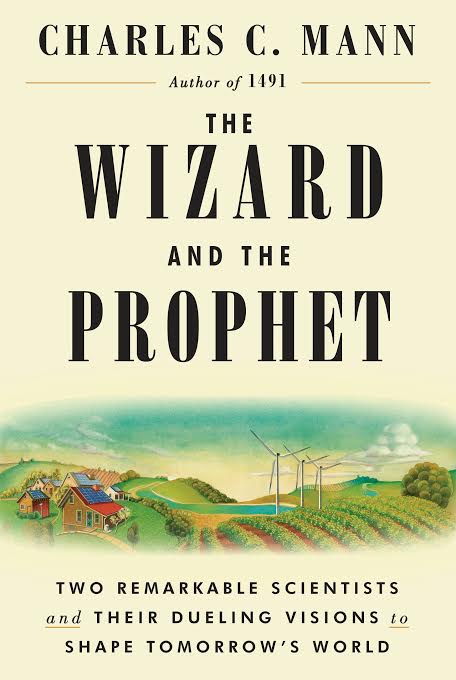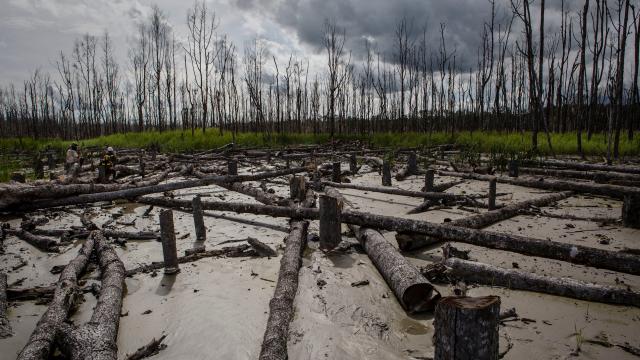By 2050, the world’s population will top ten billion people. As industrial capitalism evolves across the globe like no time in human history, will our planet’s ecosystem be able to sustain itself during this rapid transformation? Will human beings be able to support themselves with agriculture and survive on this planet, or are they doomed, like other species before them, to consume all resources and die out?
This is just one of many questions that Charles C. Mann’s grapples with in The Wizard and the Prophet.
A view of dead trees affected by gold mine waste on February 2, 2017 in Timika, Papua Province, Indonesia.Photo: Ulet Ifansasti (Getty)

The popular science author’s book studies the past to predict the future, focusing on two twentieth century scientists: Norman Borlaug and William Vogt. Their respective visions about how humanity should progress into the future still sharply divides society today. Mann assigns these opposing groups two labels: “Wizards” and “Prophets”.
The prophets are disciples of Vogt, who believed we need to reject consumerism and conserve the environment.
“Vogt said we can grow food to feed our burgeoning population, but in doing so, we will destroy the ecosystem on which our life depends,” Mann explained, from his home in rural Massachusetts.
The Wizards, meanwhile, are heirs of Borlaug, and his so-called “Green Revolution” which transformed global farming in the 1960s to produce high yield crops and lift millions out of starvation. This group looks to the future with feel-good-optimism, viewing the Earth as an inexhaustible tool box, which should be expanded, and used to its fullest potential.
“[Borlaug’s] Green Revolution was developed in rural Mexico in the late 1940s and early 1950s, and it was brought to the rest of the world — most noticeably in Asia — where it developed a farming method that yielded an enormous increase in rice, wheat, maze, and corn,” Mann explained.
Despite these developments, Mann is quick to point to the damage that has been caused by the Green Revolution’s main ingredient: nitrogen fertiliser.
“Roughly 40 per cent of the fertiliser that was poured onto the fields during the Green Revolution washed into the soil,” Mann explained. “The rest vaporized into the air in the form of nitrogen oxides, or else went into the rivers or the sea.”
“Too much nitrogen in the soil [chokes] the microorganisms on which the plants depend,” Mann added. “Nitrogen oxide [also fuels] greenhouse gas, which is bad for pollution. And nitrogen fertilises the oceans, [eventually] depleting the water of oxygen, creating enormous coastal dead zones.”
Indeed, were it not for the greater worries of climate change more generally, the spread of nitrogen would be humanity’s greatest ecological concern right now, said Mann.
The science writer pointed out how we live in a culture where climate change denial is a common occurrence. But to engage in such arguments is to deny clear, scientifically proven facts, Mann stressed. “There is very little question about the basic mechanism of climate change: the sunlight comes in and warms up the earth,” Mann explained. “And the Earth’s vegetation and water need infrared radiation that passes through the nitrogen and oxygen, which make up 90 per cent of the atmosphere.”
“Carbon dioxide absorbs those wavelengths of light that normally [allows] water vapour to get through,” Mann added. Commenting on how this will affect the future of our planet, Mann uses the analogy of a bathtub with a child in it.
“Imagine there is a bathtub and water is pouring into it. Well, that’s the sunlight,” Mann explained. “And there is these tiny little holes, around the edge of the bathtub, so that there is just enough holes in the bathtub that the child doesn’t drown.”
“And what we are doing by adding carbon dioxide is that by sheer bad luck, carbon dioxide absorbs exactly those wavelengths of light that normally water vapour lets through,” Mann added. “So it’s like putting chewing gum in the holes and gradually the [Earth’s] water will start to rise.”
This has been understood by scientists since the 1930s, Mann posited. However, what that doesn’t explain is the secondary effects that follow, which include things like the structure of the atmosphere, the direction of wind currents, and how vegetation is consequently affected too.
This brings us to the subject of climate sensitivity which scientists are still consistently asking questions about. Before the widespread use of fossil fuels in 1880, the atmospheric carbon dioxide level was about 280 parts per million. But what would happen if the number went up to 560 million parts per million? This was a question that U.S. National research Council asked back in 1979, In other words: what would happen to the Earth if we doubled the amount of carbon dioxide that presently exists in the air?
The answer the report gave back then was that it could heat up the Earth’s atmosphere between 1.5 °C to 4.5°C above the levels prevalent before the industrial revolution. That is still the figure scientists use today Mann explains: “1.5°C is not great, but still bearable,” says Mann, “4.5°C, however, is terrible news.”
If the temperature increase does indeed turn out to be closer to 4.5 °C, are there any preventable measures that could possibly halt the planet cooking itself towards a potential apocalyptic catastrophe? Geoengineering is one measure that could work. The most common method being suggested is Solar Radiation Management(SRM) which typically involves sprinkling little bits of metal or droplets of liquid into the stratosphere.
“This would reflect a certain amount of the incoming sunlight to take the top of the impact off,” Mann explained.
But geoengineering would really only buy a certain amount of time, before the gradual effects of climate change begin to take hold. It wouldn’t have the capacity to fully prevent climate change from happening. Moreover, there is also other concerns it presents, such as safety and pollution.
Another idea being suggested to fight climate change — especially by more environmentally conscious scientists — is to reforest the Sahara desert. Primarily because that would help to take carbon out of the atmosphere, “You would probably have to get the necessary water initially from desalination plants on the coast to do this,” said Mann. “But this could have a real impact on climate change in a couple of decades, because when forests get larger, they change the climate underneath them.”
“So why not use these carbon eating machines called trees, which we actually understand something about and are unlikely to have negative consequences,” Mann added.
Mann’s book is also concerned with three of the greatest challenges our planet is going to face in the coming decades, as billions of more individuals compete for resources across the globe: food, water, and energy.
Mann believes there is a widespread misconception about this latter resource especially, particularly the idea of oil reserves. “Most people think of energy reserves like there is some swimming pool of oil, coal, or gas in the ground,but that isn’t how it works,” Mann explained. “It’s a rather imprecisely defined zone. But what is actually relevant is what we can get. And usually that is quite a small percentage of the actual pool, which really we don’t know the size of.”
Mann believes the question we really need to ask ourselves is: How much of this imprecisely defined zone do we have access to in a way that makes sense for us economically?
“When you ask this, the price of oil, gas and coal fluctuates,” Mann added. “And so when they are speaking of reserves it’s really a kind of technical or economic concept.”
Mann believes the most pressing environmental concern for the planet right now is a scarcity of fresh water. “Even though there is an astonishing amount of fresh water in the world, 97 per cent of that is undrinkable and contaminated and locked up in ice caps,” he said. “So the entire amount of the Earth’s supply of fresh water is a sphere of about 48km in diameter, which is not that much, and we waste an incredible amount of it too. So there is some serious concern that water demand is going to go up.”
Mann concludes his book on an open-ended and somewhat existential note. He points out, for instance, that climate change has been studied, systematically, since about 1960, and yet, we still don’t understand, either the rate of which climate change is occurring, or its precise effects.
What shape does this then leave us Homo Sapiens in as we look to the future and towards posterity? Mann said that one lesson that biology has taught us is that living creatures profoundly shape the environment they inhabit.
“The [Darwinian] Revolution says there is only one system of biological laws, and it applies to everything. It’s evolution and [us humans] are not exceptions,” said Mann. “And one of those laws seems to be: when creatures temporally escape the bounds of natural selection — when the load of predators and environmental constraints fall away — they explode, they reproduce rapidly, they consume all the available resources, and then very bad things happen.”
According to the biologist Lynn Margulis, whom Mann once interviewed, this means that it’s the fate of every successful species to wipe itself out. Will our own species meet that same end game? A fond believer in sceptical thinking, Mann said it’s hard to definitely to commit to answer on this. Still, he hazarded a guess.
Mann concluded, “If we do survive, the [Darwinian] Revolution will have to be stepped back a little, to show that we are in fact special, that we are unlike any other creatures, despite what the biologists say.”
